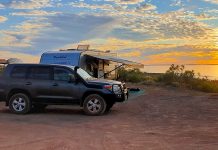I’ve been behind the wheel of quite a few motorhomes lately, each of them based on a Mercedes Sprinter. Cruising along the highway, high in my perch in the driver’s cab, each time has been an enjoyable experience. Yes, the Sprinter is an excellent motorhome base vehicle. It’s smooth, it turns on a dime, the dash is sophisticated without being unnecessarily complicated, and it provides above-average driver and passenger comfort. The rear-wheel-drive Sprinter VS30 517CDI proved an excellent choice for the subject of this review, the Winnebago Byron.
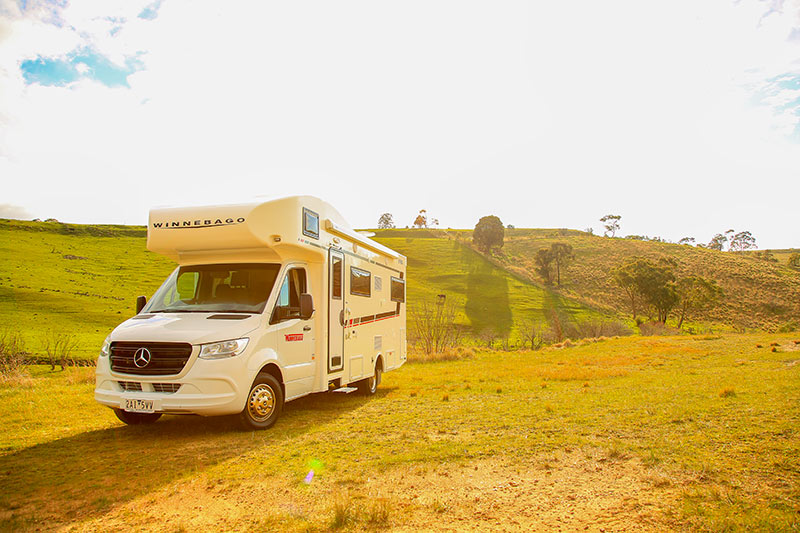 I’ll admit, my travel preference has always been caravans, but my recent motorhome travels have enhanced my appreciation for these vehicles, C class units in particular.
I’ll admit, my travel preference has always been caravans, but my recent motorhome travels have enhanced my appreciation for these vehicles, C class units in particular.
So it was with plenty of interest that I arrived at the Apollo RV depot in Campbellfield, Vic, to climb aboard the Winnebago Byron and take it for a spin.
CAR LICENCE-APPROVED
A key point to note is the weight of the Byron. In Australia, vehicles with a GVM of 4500kg or less can be driven on a standard car licence. Our Byron had a Tare weight of 3386kg and a GVM of 4490kg – no special licence required.
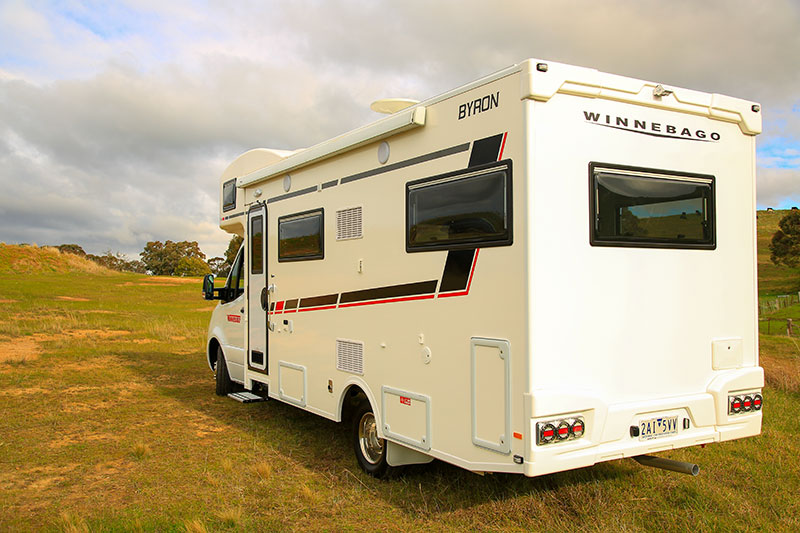 As I drove along the highway, I was pleased with the performance of the 2L four-cylinder turbo-diesel engine. From a standing start, it had no difficulty getting up to speed or keeping up with traffic. Some reasonably steep gradients required more acceleration – I wouldn’t say the vehicle struggled, but the effects of gravity were noticeable.
As I drove along the highway, I was pleased with the performance of the 2L four-cylinder turbo-diesel engine. From a standing start, it had no difficulty getting up to speed or keeping up with traffic. Some reasonably steep gradients required more acceleration – I wouldn’t say the vehicle struggled, but the effects of gravity were noticeable.
The vehicle comes with a 71L diesel tank and a 22L Adblue tank in order to meet emissions standards. It’s a nine-speed automatic transmission and it’s certainly smooth and responsive.
Of course, every motorhome comes with squeaks and rattles emanating from the living quarters. They’re to be expected and the Winnebago Byron was no different; however, these rattles were a long way from the worst I’ve experienced in a motorhome.
On a few occasions, I made use of the van’s rearview camera. The rearview mirror doubles as the camera display. On a motorhome such as this, you wouldn’t be without a rear camera – it’s a useful inclusion. The Byron is built from fibreglass composite walls with a gel-coat finish, while the floor is also a structural composite panel.
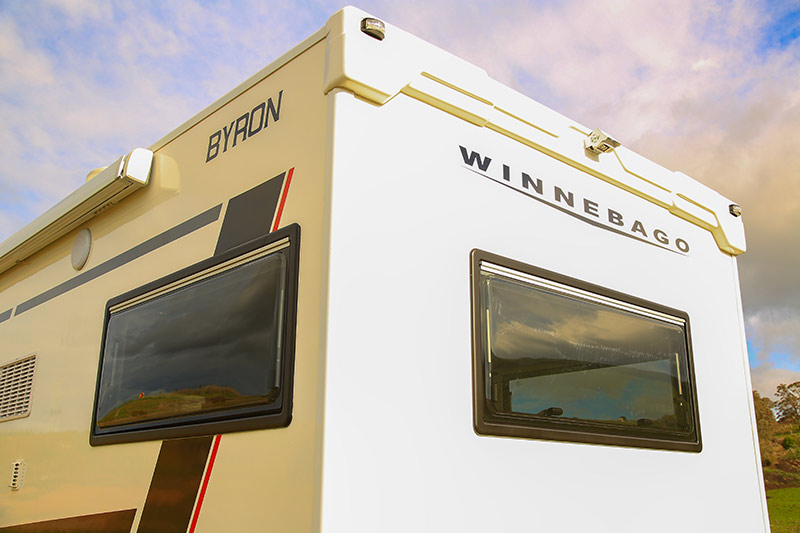 The van is equipped with a rear external shower, a 4m wind-out awning, a forward storage locker on the nearside, as well as a rear tunnel boot, not to mention a locker for the two 4.5kg gas cylinders that come with the van. On the offside, you’ll find a locker housing the van’s 12V equipment: a 135Ah deep-cycle battery (a 135Ah lithium is available as an option), fuses, and a 25A Projecta charger. A single 200W solar panel is mounted to the roof.
The van is equipped with a rear external shower, a 4m wind-out awning, a forward storage locker on the nearside, as well as a rear tunnel boot, not to mention a locker for the two 4.5kg gas cylinders that come with the van. On the offside, you’ll find a locker housing the van’s 12V equipment: a 135Ah deep-cycle battery (a 135Ah lithium is available as an option), fuses, and a 25A Projecta charger. A single 200W solar panel is mounted to the roof.
Overall, it isn’t fancy, but it’s fit for purpose and is in line with the style of touring for which this vehicle is intended: sedate blacktop adventures, staying in holiday parks, with a night or two of free-camping thrown into the mix.
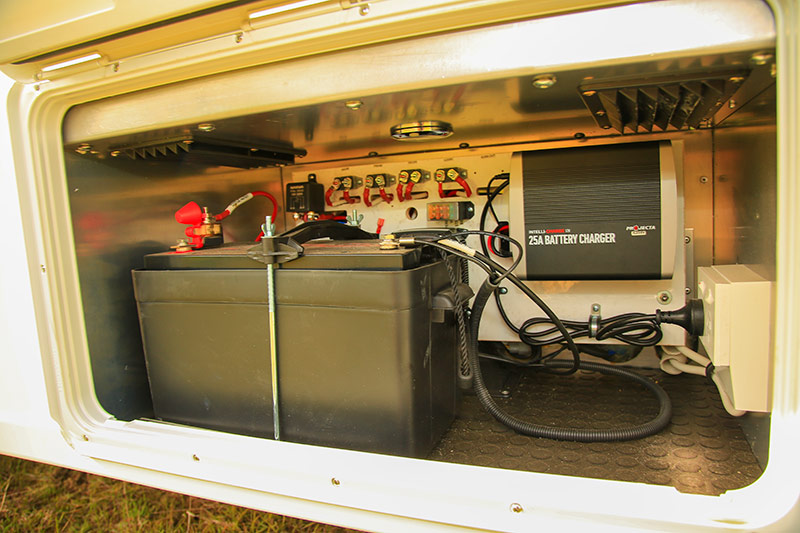 The same could be said of the water provision: it’s a 90L fresh water tank and a 90L grey water tank. Enough for one or two nights off-grid, depending on shower usage and the number of travellers. And that brings me to my next point, but first, we need to step inside…
The same could be said of the water provision: it’s a 90L fresh water tank and a 90L grey water tank. Enough for one or two nights off-grid, depending on shower usage and the number of travellers. And that brings me to my next point, but first, we need to step inside…
INSIDE THE WINNEBAGO
The Winnebago Byron is certified to carry six passengers: the driver and main passenger, and four in the dinette area immediately behind the driver’s seat. Seat belts are provided for each position, of course. A small point, but the forward-facing dinette seat comes with an anchor point to suit a baby capsule which, once upon a time, would have been great news for me! But now with the kids all grown up, they’ll simply be fighting over who gets to ride up front with dad.
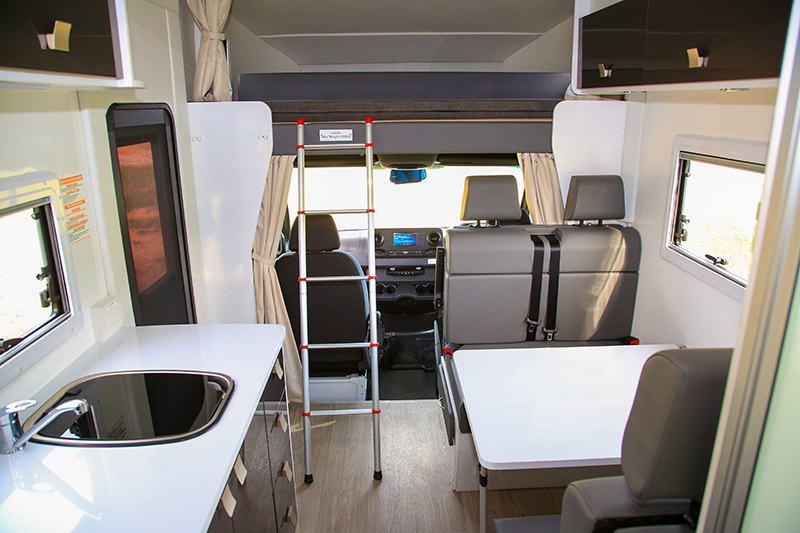 This dinette is, in fact, a secondary meals area: the Byron comes with a rear club lounge complete with a Lagun swivel table. These tables are, in my opinion, slightly superior to the table variety that requires you to feel for a catch beneath in order to slide it on its two axes. The Lagun can simply be pushed and pulled in whichever direction is required.
This dinette is, in fact, a secondary meals area: the Byron comes with a rear club lounge complete with a Lagun swivel table. These tables are, in my opinion, slightly superior to the table variety that requires you to feel for a catch beneath in order to slide it on its two axes. The Lagun can simply be pushed and pulled in whichever direction is required.
Now, this club lounge is intended to be the Byron’s main bed. However, that will require you to remove the tabletop from its supporting leg, remove that leg from its mount, and then rest the table on top of special ply lips secured to the seat bases. That then becomes the base of the bed. Simply rearrange the seat and backrest cushions to fill in the space. Unless I was travelling with kids, I would probably prefer to sleep in the second bed inside the Luton peak, the fibreglass ‘dome’ shape above the driver’s cab.
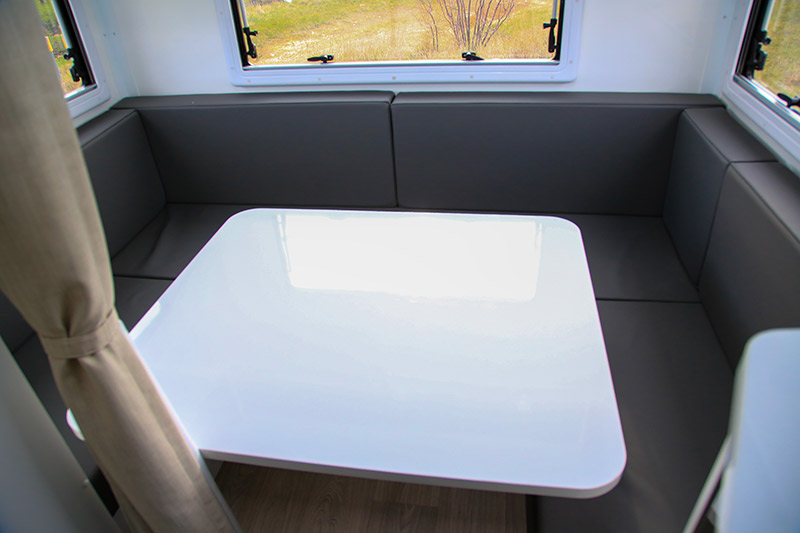 An aluminium ladder rated to 100kg is provided for easy access and when it’s not needed, it simply stows inside some clips off to the side, out of the way.
An aluminium ladder rated to 100kg is provided for easy access and when it’s not needed, it simply stows inside some clips off to the side, out of the way.
The kitchen includes a cooktop with two gas burners and one electric burner, a griller and an oven, a 25L microwave, a 153L under-bench three-way fridge, and a generous amount of bench space, particularly above the fridge. On this wall, a 22in TV has been mounted on a swing arm, with a Fusion speaker, and a 12V and 240V powerpoint nearby. There’s also a 12V point in the leg area at the forward dinette.
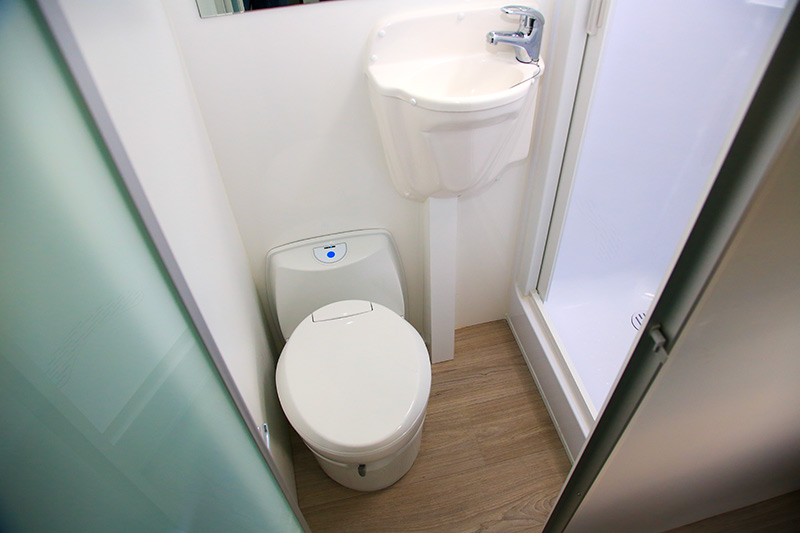 That leaves the bathroom, which is positioned in the layout on the offside, between the forward and rear lounge areas. It is equipped with a cassette toilet and small washbasin, and even a separate shower. The nature of the space has required the washbasin to be a moulded fibreglass unit mounted to the wall, rather than being part of a larger vanity unit. As a result, the drain and water lines are covered by a special vertical moulding between the basin and the floor, though it is in no way untidy.
That leaves the bathroom, which is positioned in the layout on the offside, between the forward and rear lounge areas. It is equipped with a cassette toilet and small washbasin, and even a separate shower. The nature of the space has required the washbasin to be a moulded fibreglass unit mounted to the wall, rather than being part of a larger vanity unit. As a result, the drain and water lines are covered by a special vertical moulding between the basin and the floor, though it is in no way untidy.
A small point, which I quite liked: all switches and controls have been centralised inside an overhead locker. It actually took me a minute to work out how to get 12V power to the lights… until I noticed that there were switches for each 12V circuit, from the lights to the onboard Fusion sound system that’s also inside this locker, to the 14L Truma heater and fridge. You’ll also find a Projecta voltmeter within this cupboard, which shows the battery state of charge, as well as an RV Electronics water level indicator.
 Again, the 12V system isn’t fancy, given the nature of touring of which the Byron is intended, but there is scope to upgrade, whether you wanted to add a second deep-cycle battery, swap to lithium, or even add a 1000W pure sine wave inverter to charge your devices or power 240A appliances (provided their current draw is within the scope of the inverter). You can even add a second 200W solar panel, a water filtration system, a Webasto 2kW diesel heater and more. It would, however, be worth paying attention to how these affect the van’s payload capacity.
Again, the 12V system isn’t fancy, given the nature of touring of which the Byron is intended, but there is scope to upgrade, whether you wanted to add a second deep-cycle battery, swap to lithium, or even add a 1000W pure sine wave inverter to charge your devices or power 240A appliances (provided their current draw is within the scope of the inverter). You can even add a second 200W solar panel, a water filtration system, a Webasto 2kW diesel heater and more. It would, however, be worth paying attention to how these affect the van’s payload capacity.
In standard form, there’s 908kg worth, which seem sufficient for multiple passengers and luggage. However, the payload capacity will reduce in line with the options fitted. Were you carrying six adult passengers, luggage, water, etc., the weight of the van could begin to creep quite close to the GVM. All of that said, I don’t for a moment think the Winnebago Byron has weight issues.
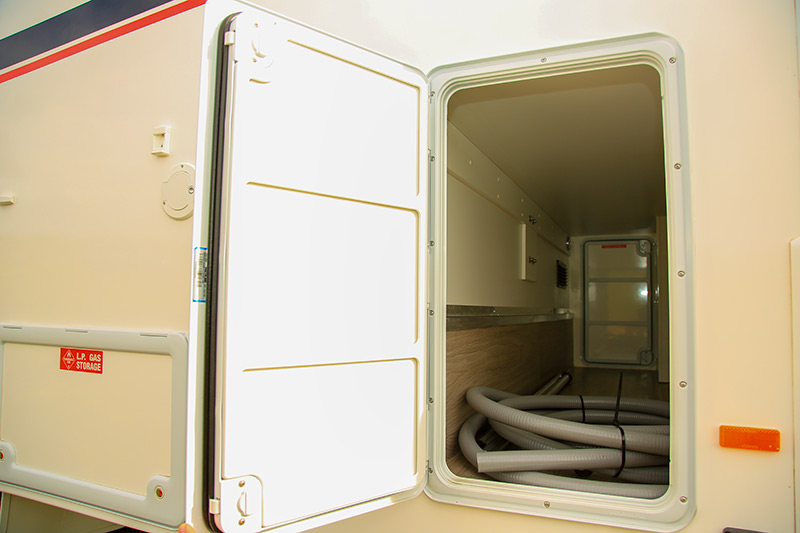 The general fitout looks good – I spotted no poor joins or rough edges. There’s plenty of internal storage options, too. But whether or not you mind converting the rear club lounge into a bed each night is a personal preference. Some would find the convenience of the club lounge worth it, I’m sure, and for those who don’t, well, there are other Winnebago models with layouts that incorporate fixed queen-size beds.
The general fitout looks good – I spotted no poor joins or rough edges. There’s plenty of internal storage options, too. But whether or not you mind converting the rear club lounge into a bed each night is a personal preference. Some would find the convenience of the club lounge worth it, I’m sure, and for those who don’t, well, there are other Winnebago models with layouts that incorporate fixed queen-size beds.
GORV’S VERDICT
I thoroughly enjoyed my time with the Winnebago Byron, from driving it along the highway, perched high in the driver’s seat with a commanding view of the road ahead, to parking up and relaxing. It certainly conveyed a sense of being ready for adventure. Just pack and go. After all, that’s one of the benefits of the motorhome lifestyle. No need to tow, or re-train your brain on how to reverse, or hitch and unhitch. There’s a simplicity to the lifestyle that’s hard to beat, and the Byron comes ready from the factory for you to get amongst it.
THE SCORE
FIT AND FINISH – [usr3.5]
LAYOUT – 
INNOVATION – 
HITS & MISSES
COMPLETE SPECS
External body length: 7.7m
External width: 2.33m (excluding rearview mirrors)
Internal height: 2.01m
Travel height: 3.2m (to top of Luton peak)
Base vehicle: Mercedes Benz Sprinter VS30 517CDI
Tare: 3386kg
GVM: 4490kg
Licence: Standard car
Engine: 2.0L four-cylinder turbo-diesel
Power: 125kW @ 3800rpm
Torque: 400Nm @ 1700-2400rpm
Transmission: Nine-speed automatic
Driven wheels: Rear
Fuel tank: 71L plus 22L AdBlue
Licence type: Standard car
Awning: 4m wind-out
Solar: Roof-mounted 200W
Gas: 2×4.5kg
Cooking: Three-burner gas cooktop with oven
Refrigeration: 153L three-way fridge-freezer
Microwave: 25L
Lighting: 12V LED
Hot water: 14L Truma
Air-conditioning: 2.4kW Truma Aventa 4 reverse-cycle
Battery: 135Ah deep-cycle with 12V 25A Projecta charger and internal voltmeter
Bathroom: Yes – cassette toilet, washbasin and separate shower
Washing machine: No
Fresh water: 90L
Grey water: 90L
RRP: $194,990



